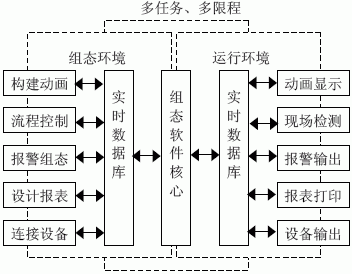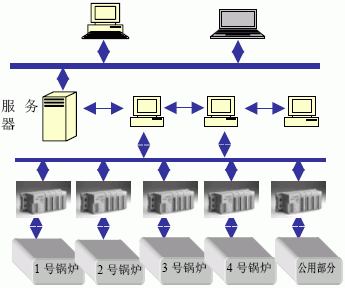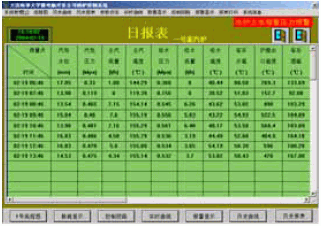1. Introduction In the past, the software functions of industrial control computer systems were implemented by software personnel. The workload is large, the software is poorly versatile, and it is prone to errors. With the continuous improvement of industrial control requirements, configuration software for industrial control emerges as the times require. It is a full-featured configuration generation tool software with strong versatility, and the execution code part of the system is generally fixed. In order to adapt to different application objects, you only need to change the data entity. At present, many companies at home and abroad have developed many excellent products, such as Fix of Intellution, Citect of Ci, and Kingview of Tsinghua Unisplendour. MCGS is one of many monitoring software that has many advantages for any monitoring system. MCGS is a set of configuration software for rapid construction and generation of computer monitoring systems. It can run on various Microsoft-based 32-bit Windows platforms, through the collection and processing of field data, animation display, alarm processing, process control and Report output and other methods provide users with solutions to practical problems, and have a wide range of applications in the field of industrial control. 2.1 The overall structure of MCGS The MCGS software system consists of two parts: the configuration environment and the operating environment. The configuration environment is equivalent to a complete set of tool software, which users can use to design and develop their own application systems. The result of the user configuration generation is a database file, the configuration result database. The operating environment is an independent operating system. It performs various processing according to the user-specified method in the configuration result database, and completes the goals and functions of the user configuration design. The configuration environment and the operating environment are independent of each other and closely related. 1 is shown. 2.2 Composition of MCGS The MCGS software system consists of a main control window, a device window, a user window, a real-time database, and a running strategy. Each part is configured separately to perform different tasks. Master window: is the main window of the project, responsible for scheduling and managing the opening or closing of these windows. The on-site control layer completes data acquisition and control of the common parts of the boiler and system; two operator stations and one engineering station are set up in the workshop monitoring layer. The operator station adopts Advantech Pentium industrial control microcomputer, which is mainly used for data display and control operation of boiler system. The two operation stations work together for hot standby. The engineering station is used for system parameter setting and system maintenance; the factory management layer is an optional function, which can perform system operation analysis, data statistics, optimization, etc.; the system has a web server, which can browse real-time data of the system through the Internet. Monitor the operating status of the system. 3.2 The function of the monitoring screen (1) Data report generation function (2) Trend curve display function (3) Alarm management function (4) System operation management function In addition to the information display and operation related to the production process, the information of the monitoring system itself (monitoring station software) also needs to be mastered in order to carry out relevant settings, parameter modification, etc., and timely adjust the monitoring station to perform various tasks in a good operating state. Therefore, the monitoring software designed the system tool screen. This screen contains tools to maintain system database security and some tools that can access high-level MCGS functionality during system development. (5) System security management function Because the monitoring software adopts GUI (Graphical User Interface) interface design, it simplifies the operation process. At the same time, due to many functions, it is easy to cause misoperation. Therefore, it is absolutely necessary to design a perfect function and use a reliable security protection system. 3.3 Application effects The boiler computer monitoring system of Dalian Maritime University works well in actual operation, the data is accurate, the system functions are complete, and the operation is convenient and fast. Reflected in the following aspects: (2) The monitoring system reflects the trend graph of the analog quantity, which can visually reproduce the past and present of the measured quantity process data. Practice has proved that this has brought great convenience to production management. (4) The use of flexible reports in the actual operation more reflects its superiority, providing the factory with an important basis for adjusting production. As shown in Figure 4. , 4, the conclusion Practical applications have proven that some of the features provided by MCGS, such as templates, libraries, and wizards, allow users to reduce the time required to configure the system while enhancing system functionality. Users can build MCGS-based real-time monitoring systems for any industrial application. The openness of MCGS in design thinking allows users to design monitoring systems that are flexible, easy to edit, and rich in picture quality and presentation.
Brando Supply Steam Solenoid Valve, Solenoid Valve For Steam, Steam And Hot Water Solenoid Valve:
1. Brass Steam Solenoid Valve
2. Stainless Steel Steam Solenoid Valve
Solenoid Valve For Steam, Steam And Hot Water Solenoid Valve, Brass Steam Solenoid Valve, Stainless Steel Steam Solenoid Valve NINGBO BRANDO HARDWARE CO.,LTD , https://www.brandopneumatic.com
2. Introduction to MCGS 
Figure 1 Relationship between the configuration environment and the operating environment
Device Window: A working environment that connects and drives external devices. Configure data acquisition and control output devices in this window; register device drivers; define data variables for connection and drive devices.
User window: It is mainly used to set the interface of human-computer interaction in the project, such as system flow chart, graph, animation, etc.
Real-time database: It is the center of data exchange and processing in all parts of the project. It connects the various parts of the MCGS project into an organic whole.
Operation strategy: Mainly complete the control of the project operation process, such as writing control programs and selecting various functional components.
3. Application of MCGS
MCGS is widely used in practice. This paper takes the boiler computer monitoring system of Dalian Maritime University as an example to introduce the specific application of MCGS.
The boiler computer monitoring system adopts an advanced hierarchical distributed network structure. The system consists of a three-layer network of field control layer, workshop monitoring layer and factory management. At the same time, through the web service function provided by the system, authorized users can access the enterprise network. View the operation of the boiler system on the campus network or on the Internet. The specific structure is shown in Figure 2. 
Figure 2 Overall structure of the system
3.1 Design of monitoring screen
The monitoring screen under the MCGS platform adopts object-oriented technology, template technology, ActiveX control technology, sub-window technology and multi-tasking technology, which changes the traditional drawing method and shortens the development cycle.
The picture of the boiler computer control system of Dalian Maritime University consists of two parts: static and dynamic. Static images generally reflect the configuration of the main devices in the system. The dynamic picture reflects the real-time operation of the device and system. According to the actual needs of the production and the main functions of the project, 12 unit flow screens, and 5 screens for monitoring the operation status of the high and low voltage distribution rooms. Data statistics analysis, fault diagnosis and operation management screens are also designed.
In order to better realize the optimal operation management of the boiler, the following functions were developed: data report generation, trend curve display, alarm management, remote control, system operation management and system security.
Mastering some important data related to boilers every month, it can more effectively arrange the operation and running time of equipment to achieve energy saving and efficiency. The system's reports combine MCGS with Microsoft Excel and Microsoft Access to create flexible, queryable reports using dynamic data exchange, ODBC technology, and Microsoft Visual Basic built into RSView32. Reports are divided into three categories: current report, daily report, and monthly report.
The trend curve is used to display the trend of each analog value. The operator can not only see past trends, but also see current trends. Through the trend chart, the trend of parameters such as drum water level and drum pressure can be seen, so that the operator can make control predictions.
An alarm is signaled when the equipment or production process ceases to operate within an acceptable, pre-set range, indicating failure, wear, or operation other than a predetermined sequence. Alarm categories include analog overrun alarms and discrete status alarms.
The system guarantees system security by setting control permissions, MCGS monitoring software platform property settings, and using desktop locks.
(1) The process flow screen shows the boiler work flow, providing a vivid and simple human-machine exchange interface for the operator to monitor the running status and control of the production equipment in the process.
(3) The alarm function is complete and the processing capability is strong. Since its inception, nearly 500 digital alarms and more than 100 analog alarms have occurred, covering almost all production facilities in the plant area, greatly facilitating alarm processing and fault analysis; as shown in Figure 3. 
Figure 3 alarm information map 
Figure 4 Daily report
references
[1] Liu Xiaoqiang. Secondary development and application of Fix configuration software in microcomputer monitoring system. Coal Science and Technology, 2000, 28(2): 15-17
[2] Zhang Yuyan. RSview32 configuration software and its application. Journal of Shenyang Electric Power College, 2002, 4(4): 43-46
[3] Wannianchun. Application of Rsview32 in the automatic monitoring system of Xinning Water Plant in Suzhou New District. China Water Supply and Drainage, 2000, 16(9): 39